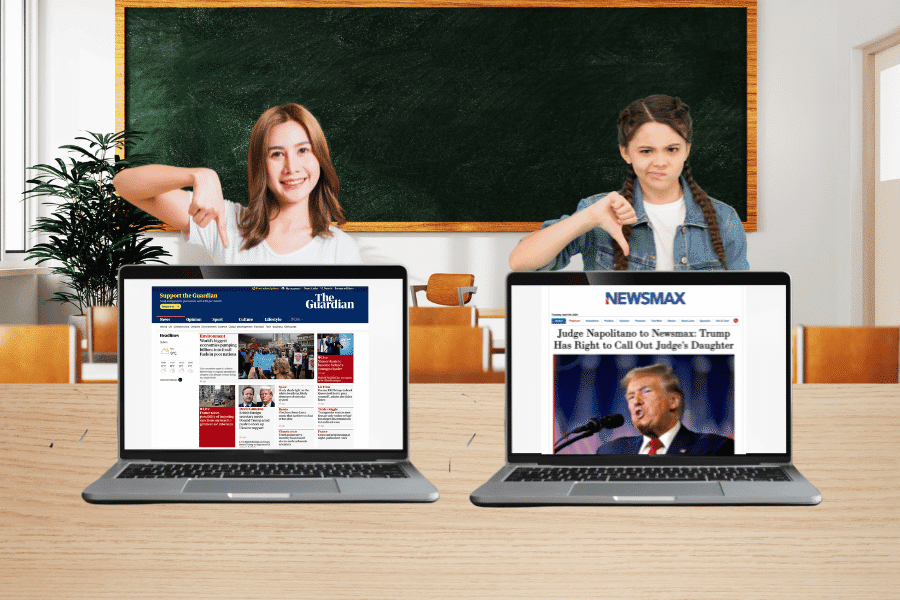
by Aralynn Abare McMane | 11 Apr 2024 | Education, Educators' Catalog, Journalism, Media Literacy, News Decoder Updates
News and media literacy groups are calling on Europe to include journalism in media literacy education. Students need to know how to spot news they can trust. A teen points to a site that can be trusted while another gives a different site a thumbs down. Illustration...
Young people engage with the news in its many, diverse forms but they can’t always trust its reliability or may not verify sources. It is vital that young people be able to discern between real news and fake, verified trustworthy sources and polemic, propaganda or clickbait. In this piece, Aralynn Abare McMane talks to news and media literacy groups and explores why they are calling for Europe to include journalism in media literacy education.
Exercise: In order to better understand the wider issues surrounding media literacy, ask students to choose one of the organizations or projects mentioned in the article. They should undertake independent research into what they do. In groups, they can look into their chosen organization or project and prepare a short presentation summarizing what they do and the key issues they address. They should then reflect on why this organization exists, what problem it solves and how its objectives help students like them in the real world.
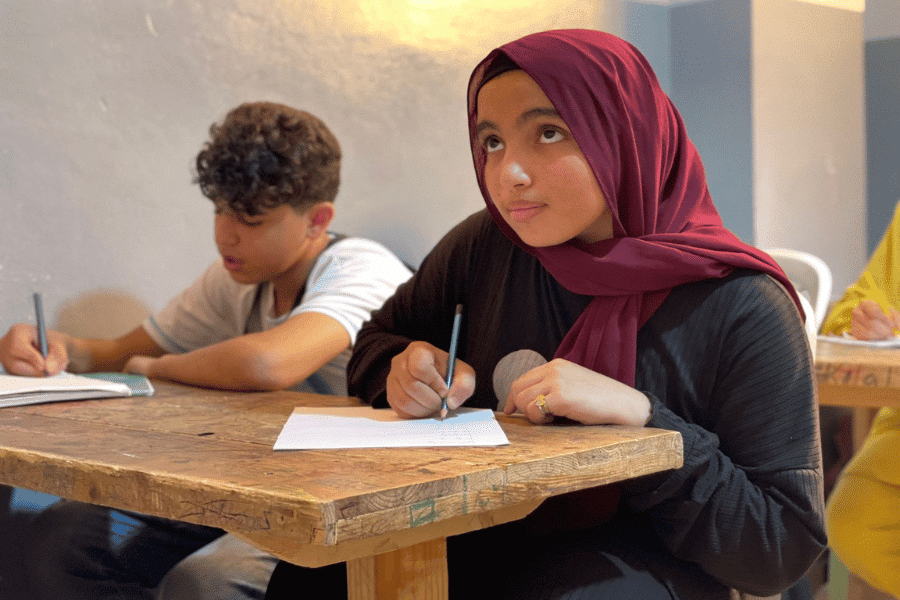
by Katharine Lake Berz | 8 Apr 2024 | Culture, Education, Educators' Catalog, Human Rights, Middle East, Syria
Desperate to give daughters a safe life, some refugees marry them off early. One organization in Lebanon is showing girls that there is an alternative. Batoul, age 13, in an Alsama classroom in Lebanon. Batoul came to Alsama two years ago illiterate because her...
Girls face barriers to education due to poverty, cultural norms and practices, traditional gender roles, societal pressure and gender inequality. Katharine Lake Berz looks at how education and gender equality play a crucial role in redressing the balance and keeping girls worldwide from early marriage.
Exercise: Read the article. Use the ‘Questions to Consider’ below it as a starting point for discussion. Find out more about the importance of girls’ education and think about why it should be a priority. For further reading and research, use the following information on girls’ education: Girls Not Brides, World Bank. Discuss why this issue should be a priority and how it relates to SDG 4 and SDG 5. You could screen this ‘School is just the start’ TED Talk by Angelina Murimirwa (8min) and discuss the key points in groups.
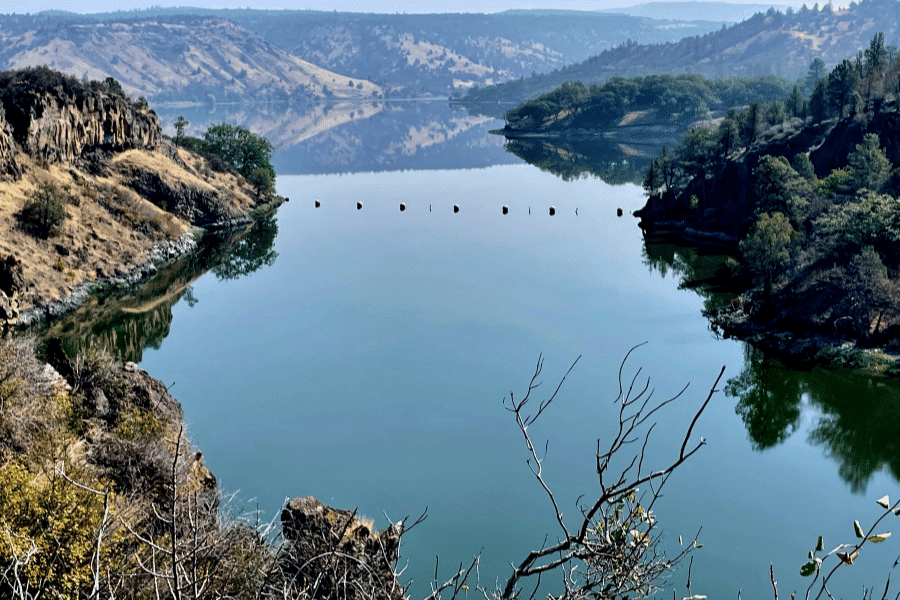
by Liam Gwynn | 29 Mar 2024 | Educators' Catalog, Environment, United States
Taking down massive dams is one thing. Now can we restore the land to what it was a century ago? The Copco 1 Dam reservoir in Hornbook, California 17 September 2023, before the dam was breached in January 2024 and the water drained. (AP Photo/Haven Daley) This article...
Well, I’ll be dammed! Correspondent Liam Gwynn dives into rivers, dams and the devastating environmental impacts of dams on river ecology.
Exercise: In groups, choose one of these five nature restoration projects. Read the summary of the project, follow the link to further reading and watch the accompanying video. Take notes, discuss and think about the environmental and social issues surrounding these projects. Who is involved in the rewilding projects? Who will benefit from them? What will nature restoration achieve? Next, imagine you are running the project and need funding. Present your project to the class in the form of a 3-minute project proposal pitch. Once every project has been presented, the class votes on which project they would fund.

by Ashley Perl | 7 Mar 2024 | Culture, Educators' Catalog, Europe, History, University of Toronto Journalism Fellows, Women
There isn’t much of a gender gap in Iceland, except in its maritime industry. But go back in time, and you’ll find women pulling in nets and steering the helm. A painting of Foreman Thurídur by Marian McConnell. Habitually clad in trousers, a rust-coloured...
For the world’s most gender-equal country, Iceland has a maritime industry that is surprisingly gender inequitable. Why and how has the status of Icelandic seafaring women regressed over the years? This piece by Ashley Perl gives an overview. In the article’s accompanying classroom activity, have students try their hand at uncovering the history of traditionally gendered professions in a research assignment well-suited for Women’s History Month.
Exercise: Read the article as a class, and then discuss the factors that have contributed to an increasing gender gap in the fishing and maritime industries in Iceland. Afterwards, have students select a profession that has a large gender imbalance in your country (perhaps teaching, nursing, engineering, etc.). Instruct students to research the history of the profession to see if these gender imbalances were the case historically, too. As part of this assignment, you may consider teaching research skills like assessing source credibility and using databases like Google Scholar.
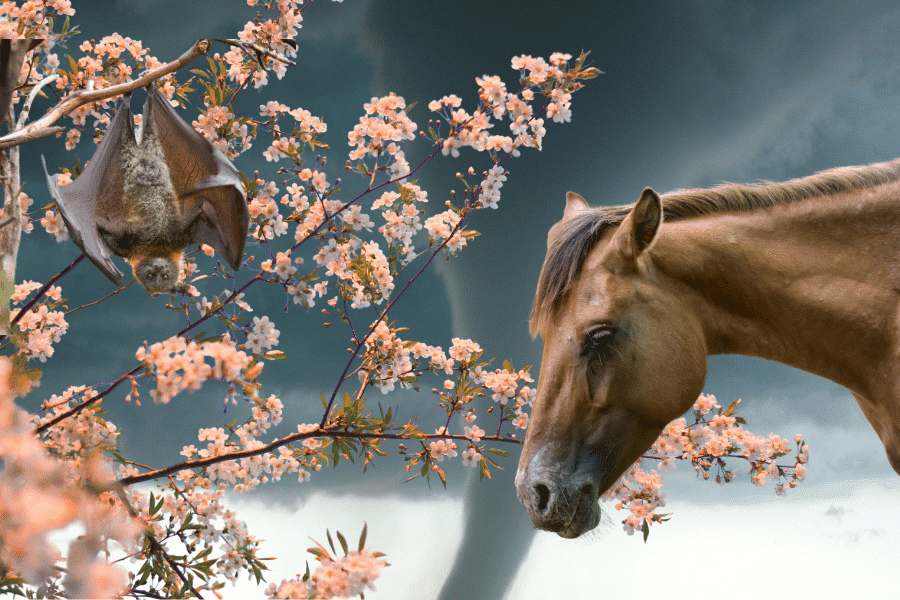
by Maggie Fox | 4 Mar 2024 | Educators' Catalog, Environment, Health and Wellness
A cyclone can affect trees which impact insects and animals spreading diseases to people. Doctors are realizing that individual health is part of an ecosystem. A bat, a flowering tree and a horse against the backdrop of a tornado. (Illustration by News Decoder) This...
How is having a C-section connected to deforestation? How can a cyclone off the coast of Australia affect the population of fruit bats and horse trainers? Health and science correspondent Maggie Fox dissects the concept of One Health for students in this latest Classroom #Decoder. In the accompanying classroom activity, get students thinking about their own thinking in an exercise in metacognition.
Exercise: With this article, students will engage in The 4 C’s protocol, adapted from Project Zero of the Harvard Graduate School of Education. Students will read the article then answer the 4 C’s. (1) What connections do students draw between the text and their own lives? (2) What ideas or assumptions in the text do they want to challenge or learn more about? (3) What is the text’s key concept or takeaway? (4) How did the text change the way students thought about the topic? Did the text inspire a change in attitude or action? Have students underline or annotate the text in response to each question. Share responses in small groups, then as a larger class.
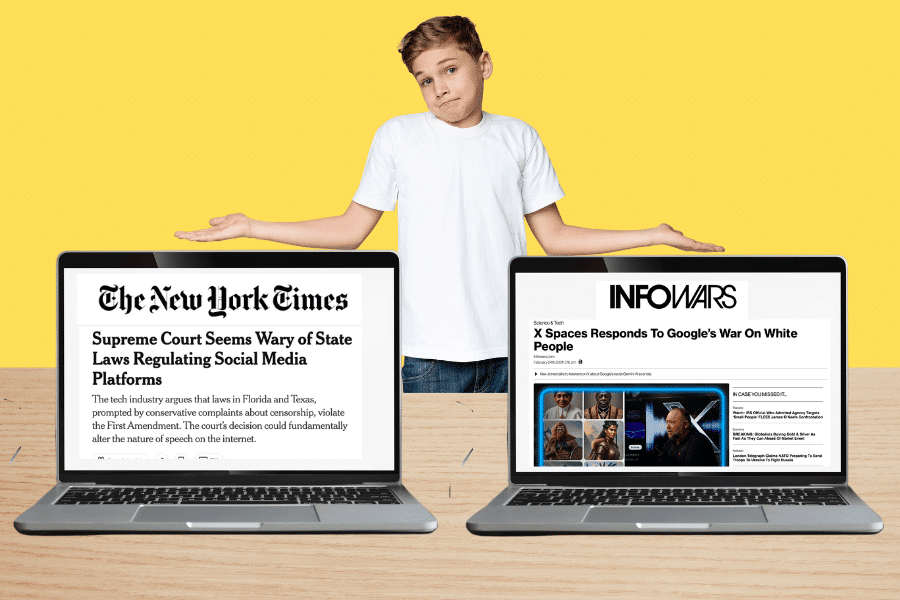
by Michael Leedom | 29 Feb 2024 | Education, Educators' Catalog, Media Literacy, University of Toronto Journalism Fellows
If a child is old enough to learn to read, it’s time to teach them to be media literate. But how to implement that in schools takes some problem solving skills. A teen shrugs at the difference between two computer screens. One shows an article by the New York...
Today’s students are digital natives, but are they digitally literate? In this Classroom #Decoder, guest writer Michael Leedom of the University of Toronto surveys media literacy curriculums around the globe, finding that media literacy education in Finland may be the world’s most robust.
Exercise: Read the article with your class, then have students try their hand at “lateral reading”. This is defined in the text as “checking the credibility of a claim by consulting other sources. Rather than remaining on a website with questionable information to find answers, known as ‘vertical reading’, students are taught to open a new tab and see if new information conflicts with what more trusted websites offer.” Present students with a web page and have them verify the credibility of that page by practicing lateral reading.
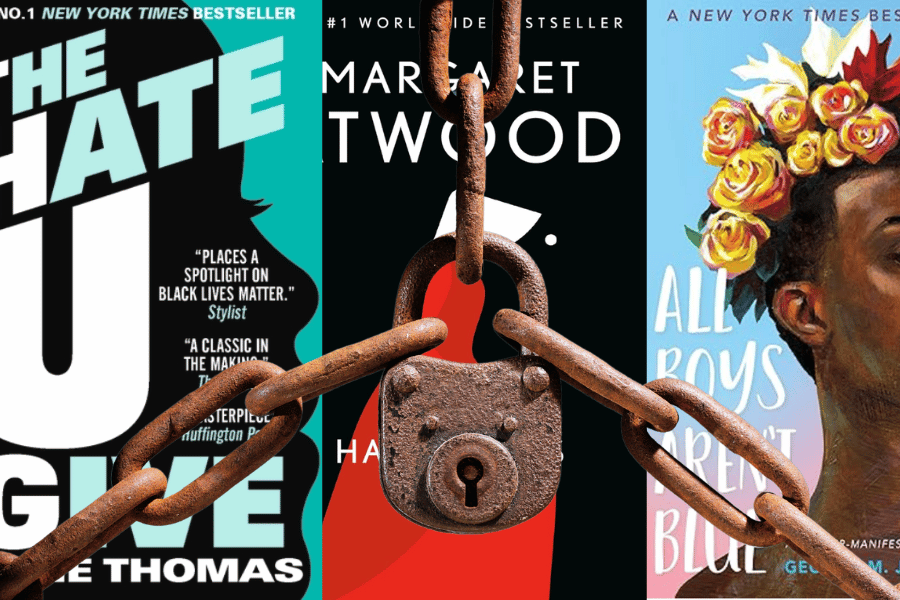
by Emily Ireland | 27 Feb 2024 | Contest winners, Culture, Education, Educators' Catalog, Media Literacy, St. Andrew's, Student Posts, Youth Voices
In more regions around the world people want to keep some books out of the hands of youth. But these are the books that engage kids the most. A heavy chain and lock covers three novels at the heart of book banning controversies. (Illustration by News Decoder) This...
Book bans have historically been linked to authoritarian regimes. In recent years, we’ve seen the rise of book bans in democratic countries, too. This is a disturbing trend, and young people are noticing, too. In this piece from high schooler Emily Ireland of St. Andrew’s Episcopal School in the U.S. state of Mississippi, prompt student thinking on censorship and banning books with an evidence-based reasoning activity.
Exercise: Read the article with your class. Then, launch a class discussion on whether there are book topics that should or shouldn’t be banned in public schools in your country. Be sure to get into the nuances of this complicated topic: if some topics are inappropriate for certain audiences, who should be responsible for restricting access? Should it be governments, parents, schools? How might these parameters change from country to country, depending on context? This activity is well-suited to be a complementary teaching tool on a lesson about civil liberties (e.g. in the United States, the Bill of Rights).

by Devon Chipman | 23 Feb 2024 | Contest winners, Education, Educators' Catalog, Student Posts, Tatnall School, Youth Voices
Some school districts across the world find that one day less of classes per week can produce more effective learning. But not everyone is convinced. Girls in school uniforms head to classes. A calendar column shows that Mondays are off. (Illustration by Kaja Andrić)...
In an excellent piece written by high schooler Devon Chipman of News Decoder partner The Tatnall School, we consider the pros and cons of a four-day school week. Develop students’ critical thinking and evidence-based reasoning skills using this youth voice story.
Exercise: Before reading the article, ask your students whether or not they support a four-day school week. Then, read the article together and see if opinions have changed. After this initial discussion, facilitate a class debate on whether or not to implement a four-day school week at your school. Students should take on different personas in the debate to argue a perspective they may not personally agree with — school administrators, teachers, parents/guardians, students, college admission officers, etc. Each student contribution during the debate should incorporate evidence from the article.

by Kaja Andrić | 19 Feb 2024 | Art, Culture, Educators' Catalog, History, Politics
For two centuries Great Britain and Greece have fought over artifacts taken from the Acropolis. In Athens, the matter of the Elgin Marbles is complicated. Ancient stones at the Parthenon on the Acropolis in Athens, Greece. (Credit: tilialucida) We climbed to the top...
News Decoder editorial intern Kaja Andrić covers the contested rights to the Greek Elgin Marbles in this text. In our present day, should the Elgin Marbles be returned from England to their historical home in Greece? Help students learn to suspend biases and adopt multiple perspectives in this accompanying classroom activity.
Exercise: Read the article as a class, instructing students to make two lists: (1) why the Elgin Marbles should remain in England and (2) why the Elgin Marbles should be returned to Greece. Then, have students draft a resolution to this dispute. If one country gives up the rights to the sculptures, what stipulations should be in place to ensure both sides are satisfied?

by Tira Shubart | 12 Feb 2024 | Educators' Catalog, Science
There are active volcanoes across the globe. When they erupt people can die and whole communities vanish. Scientists of the University of Iceland take measurements and samples standing on the ridge in front of the active part of the eruptive fissure of an active...
Living near an active volcano can be scary. Even scarier is living near an active volcano without an adequate emergency plan in place. With extreme weather events and natural disasters on the rise in recent years, help your students develop an emergency preparedness plan for their community in this piece from correspondent Tira Shubart.
Exercise: Read the article as a class and discuss why emergency preparedness plans are not equitable around the world. Then, evaluate your school and community’s level of emergency preparedness. What makes for an effective plan? Are there any weaknesses to your community’s existing emergency preparedness efforts? What could be improved?










